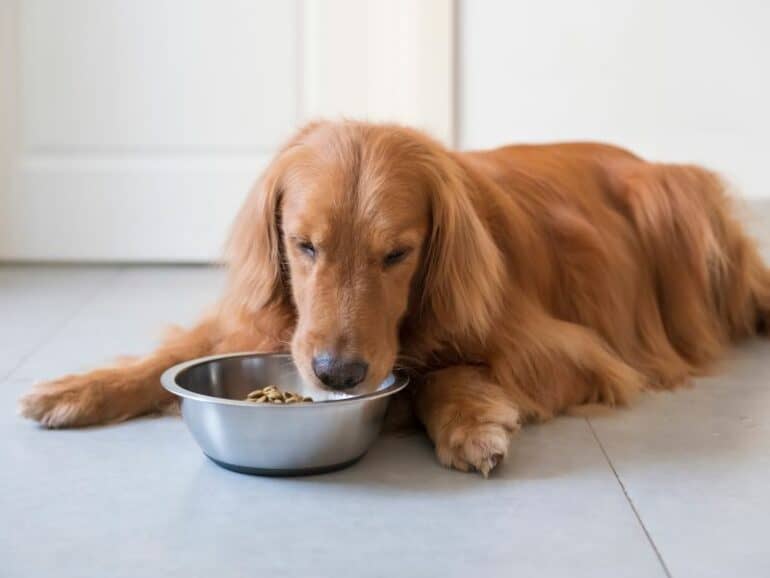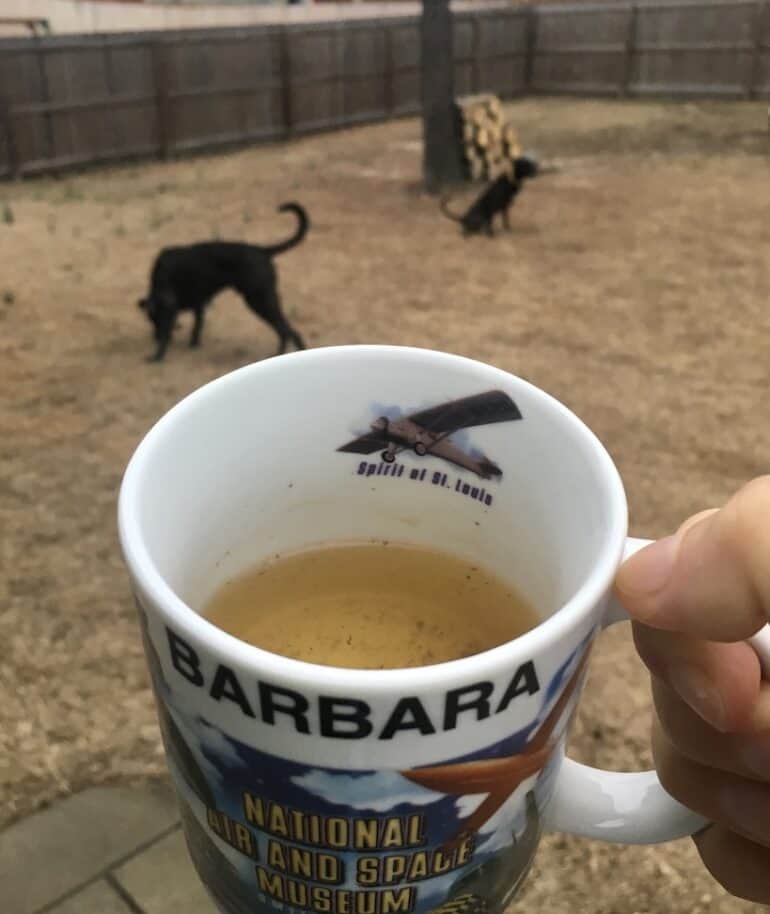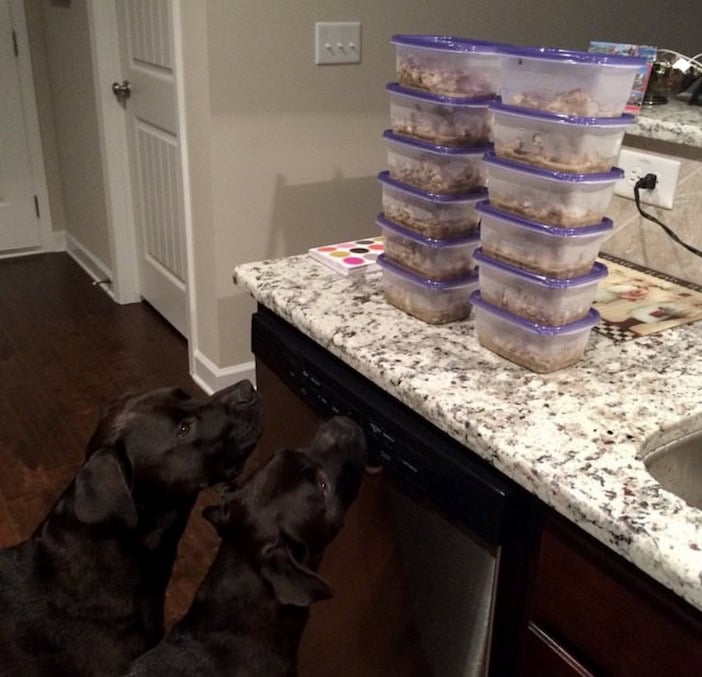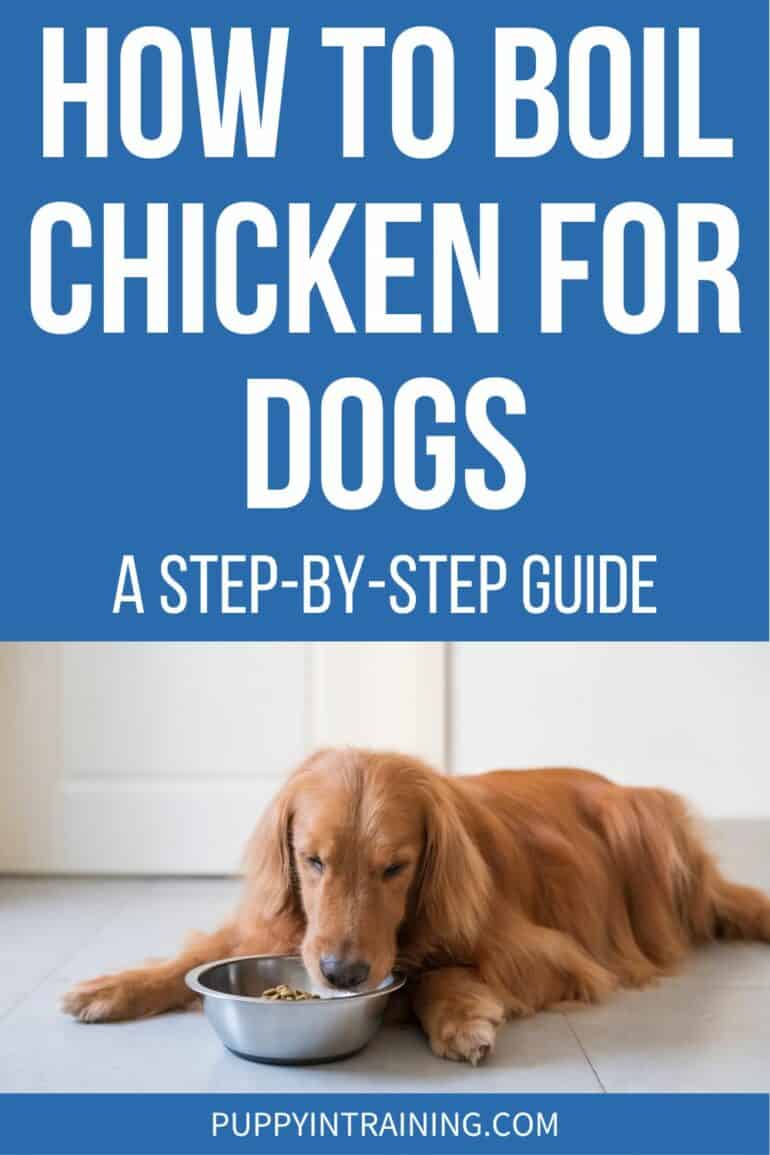How To Boil Chicken For Dogs – Step-By-Step Guide
This post may contain affiliate links. We may earn money or products from the companies mentioned in this post.
Ready to learn how to boil chicken for dogs so it remains tender and juicy?
In this blog post, we’ll guide you through the 8 step-process of boiling chicken for dogs!
Besides mastering the cooking techniques, you’ll also understand the benefits of chicken for dogs, and the different feeding options.

This includes avoiding specific cuts of chicken as well as understanding when NOT to feed your pup chicken.
Spoiler alert: I used to feed my dog Wally chicken, but these days, I no longer do.
Make sure to read through the end of this blog post to find out why and whether or not your dog may be affected as well!
Benefits of Chicken For Dogs
But first, let’s start with understanding the benefits of boiled chicken for dogs.
As a matter of fact, there’s quite a few. For instance, it’s:
- Rich in Protein: Chicken is an excellent source of high-quality protein, which is essential for muscle development, repair, and overall growth in dogs.
- A Lean Meat: Boneless, skinless chicken breasts and thighs are relatively low in fat compared to other meats. That makes it a healthier protein option for dogs, especially those with weight management concerns.
- Rich In Amino Acids: Chicken contains essential amino acids that contribute to various bodily functions. For example, maintaining healthy skin, coat, and supporting the immune system.
- Highly Digestible: Boiled or cooked chicken is easy for dogs to digest, which makes it a great choice for dogs with sensitive stomachs or those recovering from gastrointestinal upset.
- Tasty: Dogs generally find the taste of chicken appealing, which makes it a great choice for picky eaters or as a high-value treat during training sessions.
- Nutrient-Rich: Chicken is packed with essential vitamins and minerals such as vitamin B6, niacin, phosphorus, and selenium, which contribute to overall canine health.
- Low In Calories: With careful portion control, boiled chicken can be an effective part of a weight management plan for overweight dogs due to its low-fat content and high protein value.
Which Cuts Of Chicken Can I Boil For My Dog?
Having said all that, the following cuts of chicken are best to boil for your dog:
- Chicken breast
- Ground chicken
- Chicken tenders
- Boneless chicken thighs
Of course you can also cook ground chicken in a skillet, similar to hamburger meat.
But regardless of the cut of chicken you intend to boil for your dog, please never use any chicken that’s been seasoned or marinated.
Also, never cook any bones you intend on feeding!
That’s because cooking changes the bone density and makes the bones brittle.
When they are, they can easily splinter and cause damage in your dog’s esophagus and gastrointestinal tract.
Generally speaking, boneless cuts of chicken are easiest to prepare since you won’t have to debone any of the meat.
Now, if you have an entire chicken that obviously includes bone-in cuts, you can use the meaty chicken bones to make nutritious chicken bone broth.
Check out our chicken and rice blog post to learn how to prepare bone broth for dogs.
Whenever I make a batch of homemade bone broth, everyone in our home gets to have some – including the humans!
Remember how I said that Wally can no longer have chicken? That’s why these days, I make bone broth using beef bones, turkey bones and duck bones.
But I digress.

Enjoying a cup of homemade bone broth
What You’ll Need To Boil Chicken For Dogs
You’ll need to set aside about 40 minutes to boil chicken for your dog, which includes clean up time!
Here’s what you’ll need besides the chicken:
- Pot or pressure cooker
- Slotted spoon or tongs
- Cutting board
- Knife
- Fork
Optional: Food thermometer to check that the chicken has reached an internal temperature of 165° F (74° C).
How To Boil Chicken For Dogs
In general, it’s best to defrost any frozen cuts of chicken prior to boiling them.
Step 1: Prepare the Chicken
Rinse the chicken under cool water to remove any surface bacteria.
Pat the chicken dry with a paper towel.
Step 2: Cut the Chicken
Use a knife and your cutting board to cut the chicken into bite-sized pieces.
Step 3: Boiling the Chicken
In a pot, add enough water to fully submerge the chicken. As a general rule, use about 1 cup of water for every pound of chicken.
Bring the water to a rolling boil over medium-high heat.
If you use a pressure cooker or Instant Pot, make sure the lid is properly sealed and locked in place.
Depending on the type of pressure cooker you have, choose the appropriate setting for boiling or cooking poultry.
Step 4: Cooking Time
Place the chicken into the pot once the water is boiling.
Cook it thoroughly to avoid any salmonella or other bacteria.
Good to know: While healthy dogs are usually not affected by bacteria because of their acidic stomach environment, sick dogs will definitely benefit from chicken that’s cooked to an internal temperature of 165 °F.
That said, you’ll want to boil chicken for dogs for 12-15 minutes.
If you’re using a pressure cooker, turn on the heat and let the pressure cooker come up to pressure.
You’ll know it’s reached the correct pressure when the pressure valve rises, and steam starts escaping.
Once the pressure is reached, start the cooking timer.
5-8 minutes at high pressure should be long enough.
If the chicken is cut into smaller pieces, you can opt for the lower end of the cooking time range.
Step 5: Check for Doneness
Next, use a meat thermometer to ensure the chicken’s internal temperature has reached 165°F (74°C).
If it hasn’t, let it boil for a few more minutes, then check the temperature again.
Step 6: Cooling Down and Serving
Once the chicken has reached 165° F, remove it from the boiling water using a slotted spoon or tongs.
If you’re using a pressure cooker, turn off the heat.
Next, perform a quick pressure release by carefully moving the pressure valve to release the steam.
Wait for the pressure indicator to drop before safely opening the pressure cooker lid.
Allow the chicken to cool to room temperature before serving it to your dog.
The easiest way to shred the boiled chicken is with a fork (or your fingers).
Step 7: Refrigerate Or Freeze The Boiled Chicken
Refrigerate any leftover boiled chicken promptly and use it within a few days.
You can store it in the fridge for up to 4 days.
After that, you’ll want to freeze the rest in airtight food-storage containers.
You can keep any frozen chicken in your freezer for a minimum of 3 months.
I personally keep it in the freezer for up to a year.

My dogs Missy & Buzz with their homemade dog food stored in airtight food-storage containers.
Step 8: Clean Up
Last but not least, make sure to properly clean any of your kitchen surfaces that had direct contact with any raw chicken.
Hot soapy water works best for this.
Also, I recommend using plastic cutting boards over wooden ones for cutting up raw chicken.
That way, you can let the dishwasher clean them properly for you.
How To Feed Boiled Chicken For Dogs
Now, you can feed your dog boiled chicken a few different ways.
As Part Of A Bland Diet Of Chicken And Rice
If your dog is sick and your vet recommended a bland diet of chicken and rice, feed a ratio of two parts white rice to one part chicken.
White rice is easier to digest than brown rice, so stick with white rice.
As A Dog Food Topper
If your dog doesn’t have any gastrointestinal issues, you can feed boiled chicken as a tasty dog food topper.
That’s a great way to get picky dog eaters to eat their food!
When you use boiled chicken as a dog food topper, replace ¼ of their regular dog food with the chicken.
For more information on dog food toppers, check out our blog post:
My Dog Won’t Eat Dog Food But Will Eat Human Food, What Should I Do?

My client dogs Haley and Milo with boiled chicken on their kibble
In Homemade Dog Food
If you’re looking to include boiled chicken in a homemade diet, one very easy way to ensure that you’re meeting your dog’s nutritional needs is to mix it with a so-called base-or pre-mix.
These mixes consist of dehydrated or freeze-dried veggies, herbs, vitamins and minerals.
Popular base- and pre-mixes are the ones from The Honest Kitchen, Dr. Harvey’s and Grandma Lucy’s.
For example:
- The Honest Kitchen Grain-Free Veggie, Nut and Seed Base Mix
- Dr. Harvey’s Canine Health Miracle Dog Food Base Mix (with grains)
- Dr. Harvey’s Paradigm Green Superfood Base Mix (grain-free, low carb)
- Dr. Harvey’s Veg-to-Bowl Dehydrated Base Mix
- Grandma Lucy’s Artisan Freeze-Dried Pre-Mix
Check out our blog post Easy Homemade Dog Food Recipes to learn how to properly use these base-and pre-mixes!
When Not To Feed Your Dog Any Chicken
Now, while boiled chicken can be a great addition to your dog’s diet, you shouldn’t feed your dog any chicken if they have chicken allergies.
Sounds pretty straight-forward, right?
But how do you know if your dog doesn’t do well on chicken?
Well, common symptoms of a chicken allergy are lots of:
- Itching and scratching
- Excessive paw licking
- Hot spots
- Gas
I already hinted at the fact that I experienced this with my dog Wally.
He’s a 38 lb Feist mix and can’t have any chicken whatsoever.
When I adopted him a few years ago, I suspected that he may not do well with chicken as part of his raw dog food diet.
So I ended up doing a dog allergy test with him, and unfortunately, it confirmed my suspicions.
The kind I used was the Glacier Peak Holistics Pet Wellness Life Stress Scan.
It’s easy enough as all you have to do is send in a sample of your dog’s hair and saliva, and then wait for the results to be emailed your way.
Another dog allergy test kit I’m aware of is the 5 Strands Pet Food and Environmental Intolerance Test, but I personally haven’t tried this one yet.
Bottom Line
Now that you know how to boil chicken for dogs, it’s time to head into your kitchen, gather all the tools and start cooking for your dog!
But remember, while boiled chicken can be a nutritious addition to a dog’s diet, it should be served in moderation and as part of a balanced meal plan.
Always avoid feeding dogs cooked chicken bones, as they can be a choking hazard and cause gastrointestinal issues.
Additionally, don’t boil any chicken that’s been seasoned or marinated, as these ingredients are usually harmful to dogs, or will at a minimum cause digestive upset.
Last but not least, if you suspect that chicken makes your dog itchy and scratchy, try a dog allergy test to confirm or rule out a chicken allergy.
Save To Pinterest

Top Picks For Our Puppies
- BEST DOG CHEW
We Like: Beef Collagen Sticks - All of our pups love to bite, nip, and chew. We love using Collagen Sticks to help divert these unwanted behaviors. - BEST PUPPY TOY
We Like: Calmeroos Puppy Toy w/ Heartbeat and Heat Packs - Perfect for new puppies. Helps ease anxiety in their new home. - BEST DOG TREATS
We Like: Crazy Dog Train-Me Treats - We use these as our high-value treats for our guide dog puppies. - BEST FRESH DOG FOOD
We Like: The Farmer's Dog - A couple months ago we started feeding Raven fresh dog food and she loves it! Get 50% off your first order of The Farmer's Dog.
Check out more of our favorites on our New Puppy Checklist.